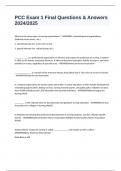PCC Exam 1 Final Questions & Answers
2024/2025
What are the three types of nursing organizations? - ANSWERS1. national/general organizations
(National nurses assoc., etc.)
2. specialty groups (ex. acute care nurses)
3. special-interests (ex. cultural group, etc.)
____________ is a professional organization to advance and protect the profession of nursing. It started
in 1896 as the Nurses Associated Alumnae. It offers professional education, liability insurance, and other
benefits for nurses, regardless of specialty area. - ANSWERSAmerican Nurses Association
_______________ is a branch of the American Nurses Association that is "the voice of nurses in Florida".
- ANSWERSFlorida Nurses Association
is a national organization for faculty nurses and leaders in nurse education. It offers faculty development,
networking opportunities, testing services, nursing research grants, and public policy initiatives to more
than 40,000 individual and 1,200 education and associate members. - ANSWERSNational League for
Nursing (NLN)
_________ is the national voice for baccalaureate and graduate nursing education. - ANSWERSAmerican
Association for Colleges in Nursing (AACN)
is dedicated to fostering the professional development of nursing students, and has a Florida-specific
branch. - ANSWERSNational Student Nurse's Association (NSNA), Florida Student Nurses Association
(FNSA)
National honor society for nursing is called _____________ and chapter at USF is called.. -
ANSWERSSigma Theta Tau International
Delta Beta at USF
,Role of nursing organizations - ANSWERSProfessional organizations and associations in nursing are
critical for generating the energy, flow of ideas, and proactive work needed to maintain a healthy
profession that advocates for the needs of its clients and nurses, and the trust of society. Allows for
networking and in case of specialty or special-interest groups connects you with nurses of similar
backgrounds and interests.
Nightingale's contribution to nursing can be succintly described as the "__________ ____________
_____________" theory - ANSWERSClean Healthy Environment- Nightingale
What was Nightingale's contribution to nursing? - ANSWERSNightingale made incredible reductions in
the amount of infection present in war hospitals, simply by insisting on proper sanitation (bed linens
being changed, wounds cleaned, hand-washing, clean food preparation, and clean water).
How is nursing practice regulated? Which organization and at which level? - ANSWERSAt the state level-
State Boards of Nursing define practice, establish criteria for licensure, scope of practice, and enforce
rules that govern nursing.
What are the different types of education RNs can have? - ANSWERSRNs can have.
1. Diploma in nursing (very rare)
2. Associate degree in nursing
3. Baccalaureate degree in nursing
Practical nursing and vocational nursing education programs are called... - ANSWERSLPN and LVN
programs
What are the different degrees an advanced practice nurse can have? - ANSWERSResearch- PhD
Nurse Practitioner, MSN, PhD
CNS (certified nurse specialist)
CNM (certified nurse-midwife)
___________ are a professional strategy to maintain current clinical knowledge for nurses and are
required by 22 states for license renewal- includes programs offered at the work site and in-service
education. - ANSWERSContinuing education (CE) hours
,The licensure examination for nurses (both registered and practical) is called the.. which stands for -
ANSWERSNCLEX-RN or NCLEX-PN (national council licensure examination) AKA the boards
Four aims of nursing - ANSWERS1. To promote health
2. To prevent illness
3. To restore health
4. To facilitate coping with a disability or death
How do we regulate nursing practice?
A. Meet state/national license and accreditation
B. Quality improvement - ANSWERSA. JCAHO & AHCA regulatory bodies to accreditate
B. Quality improvement- hospital/unit based. QSEN competencies and new focus on EBP (evidence
based practice).
_____________ are the laws that regulate practice. - ANSWERSNurse Practice Acts
__________________ define practice, establish criteria for licensure, scope of practice, and enforces
rules that govern nursing. - ANSWERSState boards of nursing
Licensure of nursing occurs through the - ANSWERSNCLEX- National Council Licensure Exam
Professional standards/ standards of nursing practice are outlined by which 2 documents... -
ANSWERSANA Standards, Code of Ethics
NCLEX stands for - ANSWERSNational Council Licensure Exam
Colostomy is a - ANSWERScolon resectioning, named differently based on which part of colon- ileostomy,
cecostomy, etc.
, Healthy stoma for an ostomy patient should appear... - ANSWERSbeefy and pink
Care of the patient with ostomy includes assessing which five factors? - ANSWERS1. Assess stoma-
healthy?
2. Assess output using COCA
3. Assess peri-stomal skin
4. Assess patient education needs
5. Assess psychosocial issues
How do we assess the output from a stoma for an ostomy patient? - ANSWERSCOCA- color, odor,
consistency, amount
How do we assess the peristomal skin for an ostomy patient? - ANSWERSIt should appear as the rest of
the skin on the body if healthy.
What are the 3 types of psychosocial issues that ostomy patients at risk for?
How can we address these? - ANSWERS1. Return to normal activities?
2. Disturbed body image
3. Sexuality
Encourage them to return to normal activities and to attend ostomy support groups.
Types of colostomy appliances include... - ANSWERSone-piece (bag + wafer together, changed
simultaneously)
two-piece (bag separate from wafer, changed separately)
Diarrhea is the increase in _________, __________ and ___________ of stools. Symptoms include
stomach cramping, increased frequency, and gassiness. - ANSWERSfrequency, volume, looseness




